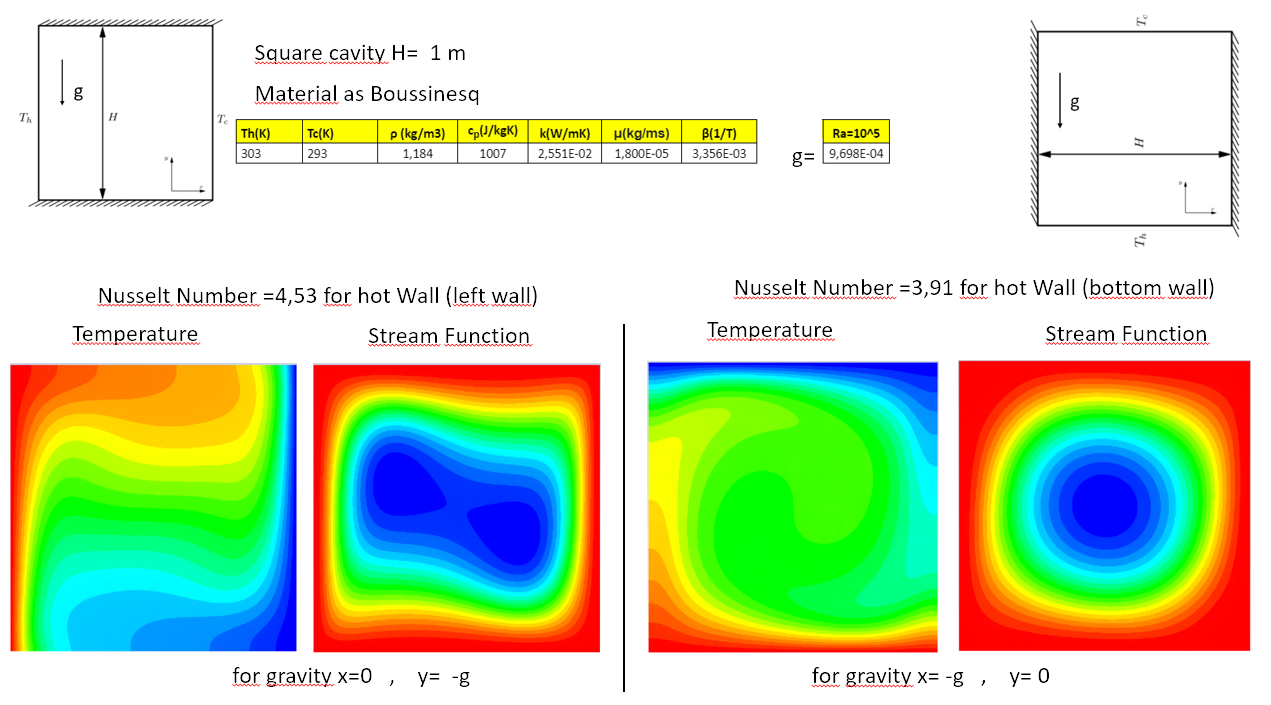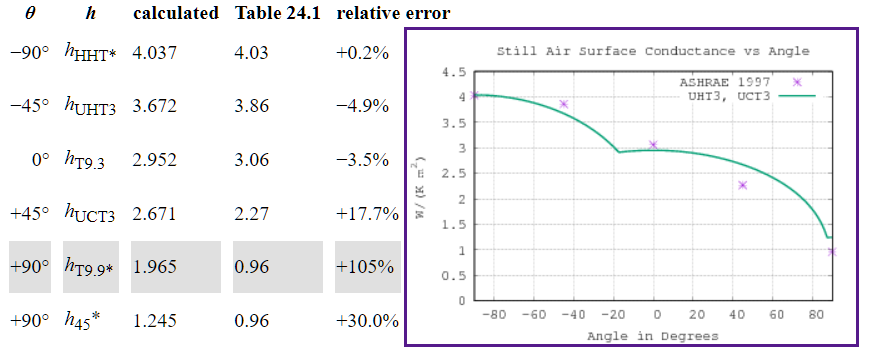 |
|
|
[Sponsors] | |||||
Fluent Natural Convection Wrong Nusselt Number |
 |
|
|
LinkBack | Thread Tools | Search this Thread | Display Modes |
|
|
|
#1 |
|
New Member
amiraladama
Join Date: May 2020
Posts: 13
Rep Power: 6  |
I edited my old thread because that was hard to understand.So I simplfy my problem.I am trying to analyze for laminar natural convection on ANSYS 2020 R1 Fluent but bottom heating nusselt number value is lower than side heating nusselt number value. It has to be the exact opposite. Let me describe my case.There is two different temperature on two walls and the other two wall is adiabatic.I took the reference value as cold wall 293 K.I am calculating the nusselt number gor just HOT wall.
 As you see the nusselt number value for bottom heating (from bottom to top) is lower than side heating (from left to right). Also what do you think about bottom heating contours (right side pictures) ? I think it should be two cell like symmetrical. Last edited by alpcfd; May 25, 2020 at 08:06. Reason: because that was hard to understand |
|
|
|

|
|
|
|
|
#2 |
|
Senior Member
|
Both of the problems are same (not in the schematic, but the way you have set those up). Why do you have different contour plots then? One reason could be convergence.
__________________
Regards, Vinerm PM to be used if and only if you do not want something to be shared publicly. PM is considered to be of the least priority. |
|
|
|

|
|
|
|
|
#3 |
|
New Member
amiraladama
Join Date: May 2020
Posts: 13
Rep Power: 6  |
Yes the problem is same. I mean there are two opposite walls with different temperature and the other opposite walls are adiabatic.The big difference between the two cases.First case, left hot and right cold, other walls are adiabatic and the second case is bottom hot and top cold, other walls are adiabatic.So I am expecting the second case (bottom hot) must be high nusselt number because of heat transfer laws you know heated air raises up and the first case (left hot) nusselt number must be lower but I can't see this on Fluent. I wonder is my opinion wrong ?
What do you mean " One reason could be convergence" ?. I can write you my residuals.Residuals set for continuity 10-5, momentum(x and y) 10-7 and energy 10-12.Do you thing is something wrong? Thank you so much for replying and giving timing. Best regards Alp |
|
|
|

|
|
|
|
|
#4 |
|
Senior Member
|
The way you have set your cases up, there is no bottom wall heating. In both cases, it is side wall heating. Therefore, I'd expect results to be same for both. That's why I doubt that it could be convergence. Residuals are not good measure for convergence. You should look at the field parameters as well, such as, velocity or pressure at a few points or averaged over certain region.
__________________
Regards, Vinerm PM to be used if and only if you do not want something to be shared publicly. PM is considered to be of the least priority. |
|
|
|

|
|
|
|
|
#5 | |
|
New Member
amiraladama
Join Date: May 2020
Posts: 13
Rep Power: 6  |
How can I set the bottom wall heating ? I tried as y= -g and Boundary conditions are bottom wall has high temperature and top wall has low temperature, left and right wall are adiabatic. Sir I found an article which name is "Nusselt–Rayleigh correlations for design of industrial elements: Experimental and numerical investigation of natural convection in tilted square air filled enclosures " and similar with my case.You can see on table 3 and 4 the difference between side heating and bottom heating as you see there bottom heating (90°) is higher than side heating (0°). I am trying to that for validation and improving my fluent skills.You can see my error sir.
[IMG]  [/IMG] [/IMG]Article link: https://www.sciencedirect.com/scienc...96890407002397 If you don't have access to science direct you can use my drive: https://drive.google.com/file/d/1w5s...ew?usp=sharing Also I did an animation for bottom heating you can see it.Actually it looks like bottom heating but after that it going different Animation : https://drive.google.com/file/d/1fGJ...ew?usp=sharing Quote:
|
||
|
|

|
||
|
|
|
#6 |
|
Senior Member
|
Bottom and Top or Right and Left are decided by gravity vector. Bottom and top are always along the gravity vector. For the first case, you have gravity along y-axis. So, the side walls are hot and cold. For the second case, change either boundary conditions or gravity direction, not both. Recommended would be to keep gravity along y-axis as in first case but boundary conditions as in second case. Then, you will have bottom heating.
__________________
Regards, Vinerm PM to be used if and only if you do not want something to be shared publicly. PM is considered to be of the least priority. |
|
|
|

|
|
|
|
|
#7 | |
|
New Member
amiraladama
Join Date: May 2020
Posts: 13
Rep Power: 6  |
Sir, I did exactly what you said.I mean gravity along y-axis and I just changed the boundary conditions but there is no changing. It is same with my previous result. Sir, Do you think the nusselt number bottom heating must be higher than side heating?( By the way for the second image I just rotated the image as bottom hot top cold.Because you know I just changed the gravity direction as -x axis and It can be confusing comparing two images For comparing easily I just rotate contour with edit.)
Quote:
|
||
|
|

|
||
|
|
|
#8 |
|
Senior Member
|
Nusselt number depends on Grashof and Prandtl. Prandtl is fixed for your case. So, as Gr increases, so does Nu. And Gr depends on length scale, temperature difference, and velocity of the flow. Length scale used is slightly different in vertical and horizontal plates, however, those can be controlled to be same, such as, for square plates. So, whichever generates higher velocity will have higher Nu. And vertical plate would end up generating higher velocity, so, I'd expect vertical heated plate to have higher Nu.
__________________
Regards, Vinerm PM to be used if and only if you do not want something to be shared publicly. PM is considered to be of the least priority. |
|
|
|

|
|
|
|
|
#9 | |
|
New Member
amiraladama
Join Date: May 2020
Posts: 13
Rep Power: 6  |
Sir, Do you have any idea why the article found values not like your thought.
The artickle which name is "Nusselt–Rayleigh correlations for design of industrial elements: Experimental and numerical investigation of natural convection in tilted square air filled enclosures" Quote:
|
||
|
|

|
||
|
|
|
#10 |
|
Senior Member
|
I suppose you are referring to the inclination of the cavity. Do note that inclination will change the Ra number, hence, the Nu. But as long as Ra is same, horizontal plate would have a low Nu. Refer
https://people.csail.mit.edu/jaffer/...zontal%20Plate
__________________
Regards, Vinerm PM to be used if and only if you do not want something to be shared publicly. PM is considered to be of the least priority. |
|
|
|

|
|
|
|
|
#11 | |
|
New Member
amiraladama
Join Date: May 2020
Posts: 13
Rep Power: 6  |
Sir, I took this plot from your URL.In the plot, 0° is vertical and 90° is horizontal (bottom hot top cold).This plot results same with my results,0° is higher than 90° but there is a big point.The big point is how -90° (top hot bottom cold) is the most higher nusselt number? I think this situation really strange.If I misunderstood the angle you know positive or negative tilt angle.Then -90° might be bottom hot and top cold so we back to the begining of my problem.I am confused.
Best regards Alp  Quote:
|
||
|
|

|
||
|
|
|
#12 |
|
Senior Member
|
The graph you are referring to is most likely for downward convection; irrelevant to your case. I shared the link so that you could observe the correlations given under heading Natural Convection with sub-headings Vertical Plate and Horizontal Plate. You can plot those correlations and then observe which one has a higher Nu for same Ra.
__________________
Regards, Vinerm PM to be used if and only if you do not want something to be shared publicly. PM is considered to be of the least priority. |
|
|
|

|
|
 |
| Tags |
| fluent, heat tranfer laminar, natural convection, nusselt number, workbench |
|
|
 Similar Threads
Similar Threads
|
||||
| Thread | Thread Starter | Forum | Replies | Last Post |
| Foam::error::PrintStack | almir | OpenFOAM Running, Solving & CFD | 92 | May 21, 2024 07:56 |
| simpleFoam parallel | AndrewMortimer | OpenFOAM Running, Solving & CFD | 12 | August 7, 2015 18:45 |
| SigFpe when running ANY application in parallel | Pj. | OpenFOAM Running, Solving & CFD | 3 | April 23, 2015 14:53 |
| Cluster ID's not contiguous in compute-nodes domain. ??? | Shogan | FLUENT | 1 | May 28, 2014 15:03 |
| DecomposePar unequal number of shared faces | maka | OpenFOAM Pre-Processing | 6 | August 12, 2010 09:01 |